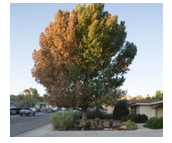July 20, 2019
Cottonwood Crisis
Question:
What could be causing my mature cottonwood tree to have started turning brown on one side all of a sudden? This started about three weeks ago. It’s watered using drip irrigation on a timer set for 10 minutes twice a day, every morning and evening. Additionally, I’ve been using a sprinkler at least two times a week for 20 minutes at a time.
- Darby D., Aztec, NM
Answer:
The photos you’ve shared show how severe the west side of the canopy has browned. There are several possible causes to consider, and it might be a combination of them.
Drought and water stress are the most likely culprits. Unfortunately, 10-minute drip and 20-minute sprinkler irrigations may not be getting the water deep enough into the soil profile. It depends largely on your soil type. In order to find out how deep the water is getting, I recommend that you wait a few hours after you water next, and then dig down in a spot where you know water was applied to see exactly how deep the water is getting. The presence of surface roots, like in the photos, suggests that water isn’t getting deep enough.
The goal is to saturate the entire root zone down to 2–3 feet deep (but especially in that top foot). The root zone is expected to be mainly at the canopy drip line and out beyond as far as four times the height of the tree! Water needs to be applied both where the roots currently are and where you want the roots to grow. Roots do not seek water, they proliferate in areas of the soil that are already moist.
On the other hand, roots also need oxygen, so the soil needs to dry between waterings. General recommendations for irrigation frequency for mature cottonwoods in New Mexico are once every week to two weeks—depending on soil type—in the summer.
A general rule about diagnosing tree problems is that symptoms that come on quickly (like the three weeks for your tree) are more likely to be caused by environmental or cultural problems than pests or disease. Environmental issues might be a hard freeze, constricted roots, drought, or heat stress. Cultural problems include watering too much or too little, but also include something drastic like a car crashing into the trunk.

Look closely at the trunk for carpenterworm borer exit holes, which will be thumb-sized holes in the bark and on the cut edges where branches were pruned but didn’t seal. The reason I think carpenterworms might be an issue for you is that we found them in cottonwoods and Navajo willows up at the fairgrounds in Farmington two years ago on trees that had major dieback. If carpenterworms are present, they still aren’t likely to be the primary problem. These types of pests are drawn to stressed trees. For videos I took when examining carpenterworm holes on trees in Farmington and Bosque Farms, visit the Desert Blooms blog version of this column.
It’s possible that circling roots weren’t an issue until this season, but now have gotten so thick that they became girdling roots and are strangling each other. If this is the case, I’m not sure much can be done. At the base of the trunk, as you walk around it, is one of the sides flat? The trunk should be more or less round. If there’s a flat side, that could be an indicator that there are girdling roots below the surface.
Circling roots are a major problem for trees. They can be caused by growing in containers too long. When lateral roots are growing outward, but bump up against the edge of the container, they turn and start to circle. The longer they circle, the worse the tangled root mass gets. Once planted, they grow normally for a while because they’re finally able to grow out laterally, but eventually the knotted roots get fat enough that they start to strangle each other and may kill the tree after growing for years—even decades—without problems. The fact is that circling roots do not self-correct underground.
Circling and girdling roots are not just a container issue, though. Compacted soils and hard barriers can cause roots to circle in the planting hole so that the tree is basically containerized in the ground. Some trees are better able to withstand circling roots than others, like the mulberry in my front yard. Surface roots near the trunk are growing sideways across the trunk base instead of outward, radially from the trunk. Maybe this will never be an issue for my tree. Maybe as soon as a major root is constricted I’ll see portions of my canopy die back too.
Marisa Y. Thompson, PhD, is the Extension Horticulture Specialist, in the Department of Extension Plant Sciences at the New Mexico State University Los Lunas Agricultural Science Center, email: desertblooms@nmsu.edu, office: 505-865-7340, ext. 113.
Links:
For more gardening information, visit the NMSU Extension Horticulture page at Desert Blooms and the NMSU Horticulture Publications page.
Send gardening questions to Southwest Yard and Garden - Attn: Dr. Marisa Thompson at desertblooms@nmsu.edu, or at the Desert Blooms Facebook page.
Please copy your County Extension Agent and indicate your county of residence when you submit your question!